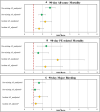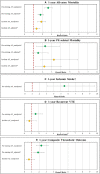Association Between Preexisting Versus Newly Identified Atrial Fibrillation and Outcomes of Patients With Acute Pulmonary Embolism
- PMID: 34459215
- PMCID: PMC8649245
- DOI: 10.1161/JAHA.121.021467
Association Between Preexisting Versus Newly Identified Atrial Fibrillation and Outcomes of Patients With Acute Pulmonary Embolism
Abstract
Background Atrial fibrillation (AF) may exist before or occur early in the course of pulmonary embolism (PE). We determined the PE outcomes based on the presence and timing of AF. Methods and Results Using the data from a multicenter PE registry, we identified 3 groups: (1) those with preexisting AF, (2) patients with new AF within 2 days from acute PE (incident AF), and (3) patients without AF. We assessed the 90-day and 1-year risk of mortality and stroke in patients with AF, compared with those without AF (reference group). Among 16 497 patients with PE, 792 had preexisting AF. These patients had increased odds of 90-day all-cause (odds ratio [OR], 2.81; 95% CI, 2.33-3.38) and PE-related mortality (OR, 2.38; 95% CI, 1.37-4.14) and increased 1-year hazard for ischemic stroke (hazard ratio, 5.48; 95% CI, 3.10-9.69) compared with those without AF. After multivariable adjustment, preexisting AF was associated with significantly increased odds of all-cause mortality (OR, 1.91; 95% CI, 1.57-2.32) but not PE-related mortality (OR, 1.50; 95% CI, 0.85-2.66). Among 16 497 patients with PE, 445 developed new incident AF within 2 days of acute PE. Incident AF was associated with increased odds of 90-day all-cause (OR, 2.28; 95% CI, 1.75-2.97) and PE-related (OR, 3.64; 95% CI, 2.01-6.59) mortality but not stroke. Findings were similar in multivariable analyses. Conclusions In patients with acute symptomatic PE, both preexisting AF and incident AF predict adverse clinical outcomes. The type of adverse outcomes may differ depending on the timing of AF onset.
Keywords: atrial fibrillation; mortality; outcome; pulmonary embolism.
Conflict of interest statement
Dr Bikdeli reports that he is a consulting expert, on behalf of the plaintiff, for litigation related to 2 specific brand models of inferior vena cava filters. Dr Jimenez has served as an advisor or consultant for Bayer HealthCare Pharmaceuticals, Boehringer Ingelheim, Bristol‐Myers Squibb, Daiichi Sankyo, Leo Pharma, Pfizer, ROVI, and Sanofi; served as a speaker or a member of a speakers' bureau for Bayer HealthCare Pharmaceuticals, Boehringer Ingelheim, Bristol‐Myers Squibb, Daiichi Sankyo, Leo Pharma, ROVI, and Sanofi; and received grants for clinical research from Daiichi Sankyo, Sanofi, and ROVI. Dr Piazza has received significant research grant support from BTG International, Bristol Myers Squibb, Daiichi‐Sankyo, Bayer, Portola, and Janssen and modest consulting fees from Pfizer and Thrombolex. Dr Lip reports that he is a consultant for Bayer/Janssen, BMS/Pfizer, Medtronic, Boehringer Ingelheim, Novartis, Verseon, and Daiichi‐Sankyo and a speaker for Bayer, BMS/Pfizer, Medtronic, Boehringer Ingelheim, and Daiichi‐Sankyo. No fees are directly received personally. Dr Goldhaber reports grants from Bayer, Boehringer‐Ingelheim, BMS, BTG EKOS, Daiichi Sankyo, Janssen, US National Heart Lung and Blood Institute, and Thrombosis Research Institute; and personal fees from Bayer and Boehringer‐Ingelheim, outside the submitted work. Dr Monreal has served as an advisor or consultant for Sanofi, Leo Pharma, and Daiichi‐Sankyo and has received a nonrestricted educational grant by Sanofi and Bayer to sponsor the RIETE registry.
Figures




References
-
- Barco S, Mahmoudpour SH, Valerio L, Klok FA, Münzel T, Middeldorp S, Ageno W, Cohen AT, Hunt BJ, Konstantinides SV. Trends in mortality related to pulmonary embolism in the European Region, 2000–15: analysis of vital registration data from the WHO Mortality Database. Lancet Respir Med. 2020;8:277–287. DOI: 10.1016/S2213-2600(19)30354-6. - DOI - PubMed
-
- Konstantinides SV, Meyer G, Becattini C, Bueno H, Geersing G‐J, Harjola V‐P, Huisman MV, Humbert M, Jennings CS, Jiménez D, et al. 2019 ESC guidelines for the diagnosis and management of acute pulmonary embolism developed in collaboration with the European Respiratory Society (ERS). Eur Heart J. 2020;41:543–603. DOI: 10.1093/eurheartj/ehz405. - DOI - PubMed
-
- Zondag W, Mos ICM, Creemers‐schild D, Hoogerbrugge ADM, Dekkers OM, Dolsma J, Eijsvogel M, Faber LM, Hofstee HMA, Hovens MMC, et al. Outpatient treatment in patients with acute pulmonary embolism: the Hestia Study. J Thromb Haemost. 2011;9:1500–1507. DOI: 10.1111/j.1538-7836.2011.04388.x. - DOI - PubMed

